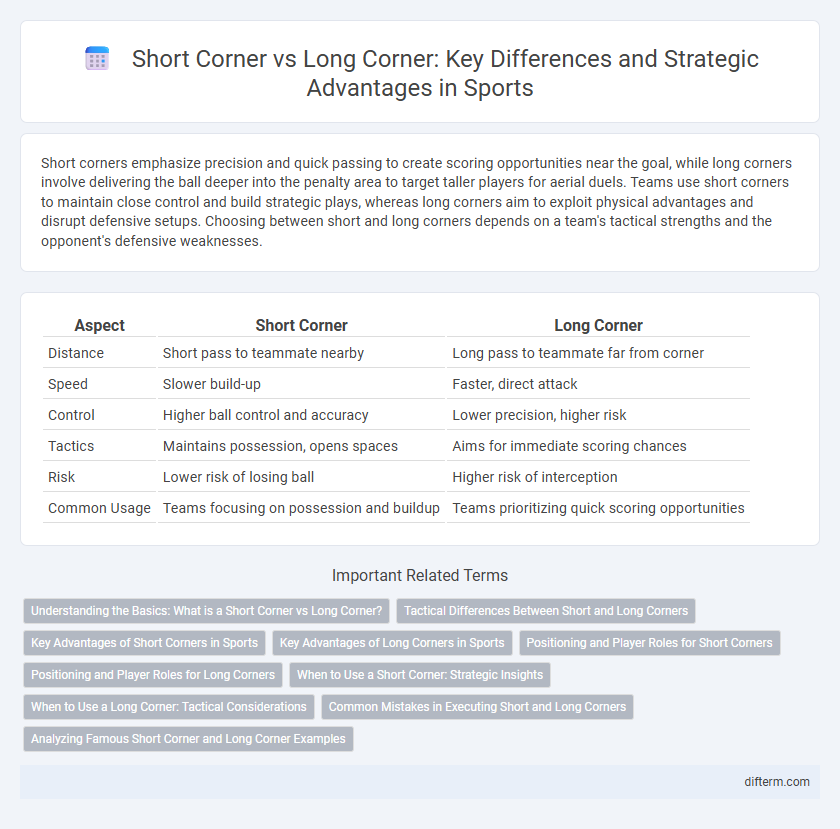Short corners emphasize precision and quick passing to create scoring opportunities near the goal, while long corners involve delivering the ball deeper into the penalty area to target taller players for aerial duels. Teams use short corners to maintain close control and build strategic plays, whereas long corners aim to exploit physical advantages and disrupt defensive setups. Choosing between short and long corners depends on a team's tactical strengths and the opponent's defensive weaknesses.
Table of Comparison
| Aspect | Short Corner | Long Corner |
|---|---|---|
| Distance | Short pass to teammate nearby | Long pass to teammate far from corner |
| Speed | Slower build-up | Faster, direct attack |
| Control | Higher ball control and accuracy | Lower precision, higher risk |
| Tactics | Maintains possession, opens spaces | Aims for immediate scoring chances |
| Risk | Lower risk of losing ball | Higher risk of interception |
| Common Usage | Teams focusing on possession and buildup | Teams prioritizing quick scoring opportunities |
Understanding the Basics: What is a Short Corner vs Long Corner?
A short corner in sports like soccer occurs when the ball is passed to a nearby teammate instead of being crossed directly into the penalty area, promoting better control and tactical buildup. A long corner, by contrast, involves sending the ball deep into the opponent's box, aiming for aerial duels and immediate scoring opportunities. Understanding these corner strategies enhances team offensive dynamics and can significantly influence the outcome of set-piece plays.
Tactical Differences Between Short and Long Corners
Short corners prioritize quick, precise passes and player movement to exploit space near the penalty area, enhancing control and reducing the risk of turnovers. Long corners rely on delivering crosses into the box, leveraging aerial strength to create scoring chances through headers or rebounds. The tactical choice depends on team strengths, opponent weaknesses, and the desired tempo of play during set pieces.
Key Advantages of Short Corners in Sports
Short corners in sports such as soccer offer precise control and increased passing accuracy, enabling teams to maintain possession effectively in tight spaces. The reduced distance between players during a short corner facilitates quick combination plays and the ability to exploit defensive gaps. This method also allows for better coordination and timing, increasing the likelihood of successful set-piece execution compared to long corners.
Key Advantages of Long Corners in Sports
Long corners in sports provide key advantages by creating more space and time for attackers to execute precise crosses and set-piece plays. The extended delivery angle increases the likelihood of disrupting defensive formations, allowing teammates to capitalize on scoring opportunities. Teams leveraging long corners often benefit from enhanced ball control and strategic positioning in the opponent's penalty area.
Positioning and Player Roles for Short Corners
Short corners require precise positioning near the corner flag, emphasizing quick, close-range passes that exploit tight spaces. Players involved typically include a crosser skilled in low-driven balls, a near-post runner aiming to create direct scoring opportunities, and a spotter positioned just outside the penalty area for second balls. Roles focus on rapid coordination, sharp spatial awareness, and rapid decision-making to maintain possession and disrupt defensive setups.
Positioning and Player Roles for Long Corners
Long corners require precise positioning, with attackers positioned near the near post and midfielders prepared to capitalize on rebounds around the penalty spot. Defenders often mark key opposition players tightly while others cover potential clearance zones at the outer box. Goalkeepers play a crucial role in commanding the near post area and anticipating inswinging deliveries to minimize scoring chances.
When to Use a Short Corner: Strategic Insights
A short corner is strategically used when a team aims to maintain close control and create unpredictable passing angles near the goal area, often catching defenders off guard. It is most effective against opponents who press high or leave gaps in defensive coverage, allowing precise crosses or quick shots. Utilizing a short corner enhances ball retention and opens space for teammates to exploit defensive weaknesses.
When to Use a Long Corner: Tactical Considerations
Using a long corner in football is strategic when aiming to exploit aerial strength or target tall players in the opponent's penalty area. It is particularly effective against teams that defend narrowly or struggle with set pieces involving high crosses. Coaches may opt for long corners to create chaos and increase scoring opportunities by delivering the ball directly into the crowded box.
Common Mistakes in Executing Short and Long Corners
Common mistakes in executing short corners include poor communication between players and insufficient angle creation, leading to easy interceptions by defenders. In long corners, improper ball delivery height and lack of targeted positioning reduce scoring opportunities and allow opponents to clear the ball effectively. Mastering precise delivery and coordinated movement is essential for capitalizing on set-piece chances in both short and long corners.
Analyzing Famous Short Corner and Long Corner Examples
Famous short corner examples, such as Barcelona's tiki-taka style, emphasize quick, precise passes to disrupt defenses and create scoring opportunities in tight spaces. Long corners, exemplified by Leicester City's counter-attacking strategy, leverage direct, powerful deliveries into the box to exploit aerial duels and chaos in the opponent's penalty area. Analyzing these approaches highlights how situational awareness and team strengths dictate the choice between short and long corners for maximum effectiveness.
short corner vs long corner Infographic

 difterm.com
difterm.com